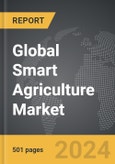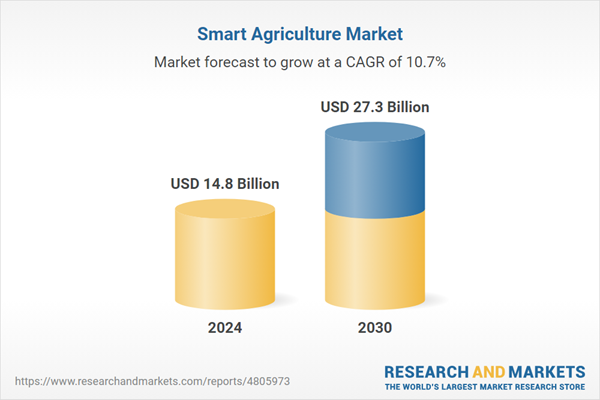The global market for Smart Agriculture was valued at US$14.8 Billion in 2024 and is projected to reach US$27.3 Billion by 2030, growing at a CAGR of 10.7% from 2024 to 2030. This comprehensive report provides an in-depth analysis of market trends, drivers, and forecasts, helping you make informed business decisions. The report includes the most recent global tariff developments and how they impact the Smart Agriculture market.
The implementation of smart agriculture involves several key technologies and tools. Drones and satellite imagery provide detailed aerial views of farmland, helping to identify issues such as pest infestations, nutrient deficiencies, and water stress that are not easily detectable from the ground. Automated machinery, such as GPS-guided tractors and robotic harvesters, ensures precision in planting, tending, and harvesting crops. Additionally, advanced software platforms offer comprehensive farm management solutions, integrating data from various sources to provide actionable insights and facilitate strategic planning. These platforms often include features like predictive analytics for yield forecasting, market trend analysis, and supply chain management, helping farmers make better-informed decisions.
The growth in the smart agriculture market is driven by several factors reflecting the evolving needs and challenges in the agricultural sector. The increasing global population and subsequent demand for food necessitate more efficient and sustainable farming practices, pushing the adoption of smart agriculture technologies. Climate change and unpredictable weather patterns also drive the need for precise and adaptive farming methods to ensure crop resilience and food security. Technological advancements, such as improvements in sensor technology, AI, and IoT, have made these solutions more accessible and affordable for farmers. Additionally, government initiatives and subsidies promoting sustainable farming practices and technological adoption are significant growth drivers. The trend towards organic and high-quality food products has further fueled the demand for smart agriculture, as these technologies help in maintaining stringent quality standards. Moreover, the integration of blockchain technology for traceability and transparency in the food supply chain is emerging as a key factor in the market’s expansion. These drivers collectively ensure a robust growth trajectory for the smart agriculture market, positioning it as a critical component of the future of farming.
Segments: Offering (Hardware, Software, Services); Agriculture Type (Precision Farming, Livestock Monitoring, Fish Farming, Smart Greenhouse, Other Agriculture Types).
Geographic Regions/Countries: World; USA; Canada; Japan; China; Europe; France; Germany; Italy; UK; Rest of Europe; Asia-Pacific; Rest of World.
The analysts continuously track trade developments worldwide, drawing insights from leading global economists and over 200 industry and policy institutions, including think tanks, trade organizations, and national economic advisory bodies. This intelligence is integrated into forecasting models to provide timely, data-driven analysis of emerging risks and opportunities.
Global Smart Agriculture Market - Key Trends & Drivers Summarized
Smart agriculture, also known as precision farming or digital agriculture, leverages advanced technologies to enhance the efficiency and productivity of agricultural practices. This approach integrates the Internet of Things (IoT), artificial intelligence (AI), machine learning, and big data analytics to monitor and manage agricultural activities with unprecedented precision. Smart agriculture systems use sensors to collect data on soil moisture, nutrient levels, crop health, and weather conditions, which is then analyzed to make informed decisions about irrigation, fertilization, and pest control. This real-time data-driven approach allows farmers to optimize resource use, increase crop yields, and reduce environmental impact, making farming more sustainable and profitable.The implementation of smart agriculture involves several key technologies and tools. Drones and satellite imagery provide detailed aerial views of farmland, helping to identify issues such as pest infestations, nutrient deficiencies, and water stress that are not easily detectable from the ground. Automated machinery, such as GPS-guided tractors and robotic harvesters, ensures precision in planting, tending, and harvesting crops. Additionally, advanced software platforms offer comprehensive farm management solutions, integrating data from various sources to provide actionable insights and facilitate strategic planning. These platforms often include features like predictive analytics for yield forecasting, market trend analysis, and supply chain management, helping farmers make better-informed decisions.
The growth in the smart agriculture market is driven by several factors reflecting the evolving needs and challenges in the agricultural sector. The increasing global population and subsequent demand for food necessitate more efficient and sustainable farming practices, pushing the adoption of smart agriculture technologies. Climate change and unpredictable weather patterns also drive the need for precise and adaptive farming methods to ensure crop resilience and food security. Technological advancements, such as improvements in sensor technology, AI, and IoT, have made these solutions more accessible and affordable for farmers. Additionally, government initiatives and subsidies promoting sustainable farming practices and technological adoption are significant growth drivers. The trend towards organic and high-quality food products has further fueled the demand for smart agriculture, as these technologies help in maintaining stringent quality standards. Moreover, the integration of blockchain technology for traceability and transparency in the food supply chain is emerging as a key factor in the market’s expansion. These drivers collectively ensure a robust growth trajectory for the smart agriculture market, positioning it as a critical component of the future of farming.
Report Scope
The report analyzes the Smart Agriculture market, presented in terms of units. The analysis covers the key segments and geographic regions outlined below.Segments: Offering (Hardware, Software, Services); Agriculture Type (Precision Farming, Livestock Monitoring, Fish Farming, Smart Greenhouse, Other Agriculture Types).
Geographic Regions/Countries: World; USA; Canada; Japan; China; Europe; France; Germany; Italy; UK; Rest of Europe; Asia-Pacific; Rest of World.
Key Insights:
- Market Growth: Understand the significant growth trajectory of the Hardware segment, which is expected to reach US$16.7 Billion by 2030 with a CAGR of a 10.1%. The Software segment is also set to grow at 12.0% CAGR over the analysis period.
- Regional Analysis: Gain insights into the U.S. market, valued at $4.5 Billion in 2024, and China, forecasted to grow at an impressive 13.7% CAGR to reach $2.8 Billion by 2030. Discover growth trends in other key regions, including Japan, Canada, Germany, and the Asia-Pacific.
Why You Should Buy This Report:
- Detailed Market Analysis: Access a thorough analysis of the Global Smart Agriculture Market, covering all major geographic regions and market segments.
- Competitive Insights: Get an overview of the competitive landscape, including the market presence of major players across different geographies.
- Future Trends and Drivers: Understand the key trends and drivers shaping the future of the Global Smart Agriculture Market.
- Actionable Insights: Benefit from actionable insights that can help you identify new revenue opportunities and make strategic business decisions.
Key Questions Answered:
- How is the Global Smart Agriculture Market expected to evolve by 2030?
- What are the main drivers and restraints affecting the market?
- Which market segments will grow the most over the forecast period?
- How will market shares for different regions and segments change by 2030?
- Who are the leading players in the market, and what are their prospects?
Report Features:
- Comprehensive Market Data: Independent analysis of annual sales and market forecasts in US$ Million from 2024 to 2030.
- In-Depth Regional Analysis: Detailed insights into key markets, including the U.S., China, Japan, Canada, Europe, Asia-Pacific, Latin America, Middle East, and Africa.
- Company Profiles: Coverage of players such as Accenture PLC, AGCO Corporation, AeroVironment, Inc., Aerofarms LLC, Afimilk Ltd. and more.
- Complimentary Updates: Receive free report updates for one year to keep you informed of the latest market developments.
Some of the 199 companies featured in this Smart Agriculture market report include:
- Accenture PLC
- AGCO Corporation
- AeroVironment, Inc.
- Aerofarms LLC
- Afimilk Ltd.
- AG Leader Technology
- Aerial Technology International
- 4D Bios Inc.
- AEssense Grows
- AFFINOR Growers
- AgCode, Inc.
- Adas Hightex Pte Ltd.
- Agam Greenhouse
- 365FarmNet
- AgBridge
Tariff Impact Analysis: Key Insights for 2025
Global tariff negotiations across 180+ countries are reshaping supply chains, costs, and competitiveness. This report reflects the latest developments as of April 2025 and incorporates forward-looking insights into the market outlook.The analysts continuously track trade developments worldwide, drawing insights from leading global economists and over 200 industry and policy institutions, including think tanks, trade organizations, and national economic advisory bodies. This intelligence is integrated into forecasting models to provide timely, data-driven analysis of emerging risks and opportunities.
What’s Included in This Edition:
- Tariff-adjusted market forecasts by region and segment
- Analysis of cost and supply chain implications by sourcing and trade exposure
- Strategic insights into geographic shifts
Buyers receive a free July 2025 update with:
- Finalized tariff impacts and new trade agreement effects
- Updated projections reflecting global sourcing and cost shifts
- Expanded country-specific coverage across the industry
Table of Contents
I. METHODOLOGYII. EXECUTIVE SUMMARY2. FOCUS ON SELECT PLAYERSIII. MARKET ANALYSISIV. COMPETITION
1. MARKET OVERVIEW
3. MARKET TRENDS & DRIVERS
4. GLOBAL MARKET PERSPECTIVE
UNITED STATES
CANADA
JAPAN
CHINA
EUROPE
FRANCE
GERMANY
ITALY
UNITED KINGDOM
REST OF EUROPE
ASIA-PACIFIC
REST OF WORLD
Companies Mentioned (Partial List)
A selection of companies mentioned in this report includes, but is not limited to:
- Accenture PLC
- AGCO Corporation
- AeroVironment, Inc.
- Aerofarms LLC
- Afimilk Ltd.
- AG Leader Technology
- Aerial Technology International
- 4D Bios Inc.
- AEssense Grows
- AFFINOR Growers
- AgCode, Inc.
- Adas Hightex Pte Ltd.
- Agam Greenhouse
- 365FarmNet
- AgBridge
Table Information
| Report Attribute | Details |
|---|---|
| No. of Pages | 501 |
| Published | April 2025 |
| Forecast Period | 2024 - 2030 |
| Estimated Market Value ( USD | $ 14.8 Billion |
| Forecasted Market Value ( USD | $ 27.3 Billion |
| Compound Annual Growth Rate | 10.7% |
| Regions Covered | Global |









